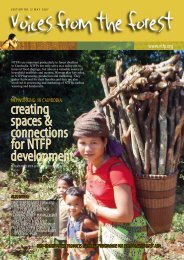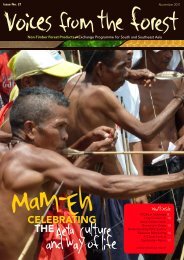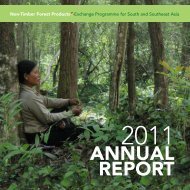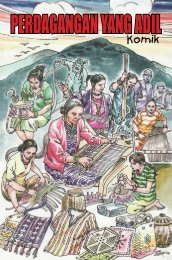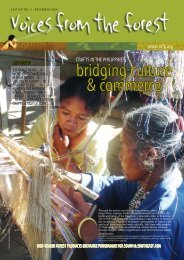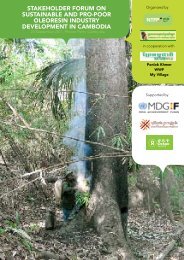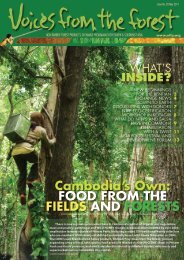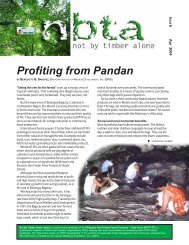annual report - Non-Timber Forest Products Exchange Programme
annual report - Non-Timber Forest Products Exchange Programme
annual report - Non-Timber Forest Products Exchange Programme
Create successful ePaper yourself
Turn your PDF publications into a flip-book with our unique Google optimized e-Paper software.
2012ANNUALREPORT
ACRONYMSAGMIHICUAMANASEANASFCCASFNAIPPCADTCBECBHECCA/DRRCLAPSCMCCCNWGCSODOSTDOTDTIFAFDSFFIFMIPFPICFRAICCAIMRIPIUCNJMHIMAFFMGFNGPNTFPPGSPRMPTRIREDDRFRIRSPOSIESHGsUNDRIPWWFAgtulawon Mintapod Higaonon CumadonAliansi Masyarakat Adat NusantaraAssociation of Southeast Asian NationsASEAN-Swiss Partnership on Social <strong>Forest</strong>ry and Climate ChangeASEAN Social <strong>Forest</strong>ry NetworkAsian Indigenous Peoples PactCertificate of Ancestral Domain TitleCommunity-Based EnterprisesCommunity-Based Wild Honey EnterprisesClimate Change Adaptation and Disaster Risk ReductionCommunity Livelihood Appraisal and Product/Resource ScanningCustomMade Crafts CenterCambodia NTFP Working GroupCivil Society OrganizationDepartment of Science and TechnologyDepartment of TourismDepartment of Trade and Industry<strong>Forest</strong>ry Administration<strong>Forest</strong>ry Department of SarawakFauna and Flora InternationalFinancial Management Improvement PlanFree and Prior Informed Consent<strong>Forest</strong> Rights ActIndigenous and Community Conserved AreasImpact Monitoring ReportIndigenous PeoplesInternational Union for Conservation of NatureJaringan Madu Hutan IndonesiaMinistry of Agriculture, <strong>Forest</strong>ry and FisheriesMicroGrants FundNational Greening Program<strong>Non</strong>-<strong>Timber</strong> <strong>Forest</strong> <strong>Products</strong>Participatory Guarantee SystemParticipatory Resource MonitoringPhilippine Textile Research InstituteReducing Emissions from Deforestation and <strong>Forest</strong> DegradationRainforest Restoration InitiativeRound Table for Sustainable Palm OilSouthern Institute of EcologySelf-Help GroupsUnited Nations Declaration on the Rights of Indigenous PeoplesWorld Wide Fund for Natureii
TABLE OF CONTENTSiiiiiiv134567810111213141516171820222426AcronymsTable of ContentsMessage from the PresidentWho we are, What we do2012 in ReviewThematic OutcomesConservationClimate ChangeFood & Health SecurityIncome GenerationLand Rights, Tenure and PolicyMicrogrants FundCountry InitiativesCambodiaIndiaIndonesiaMalaysiaPhilippinesVietnamOrganizational UpdatesChallenges and Lessons LearnedLooking Forward to 2013Financial Reportiii
Talking with Balan about the declaration of a Tiger Reserve in India, he said, “...if the forest isnot there, nothing will remain for us....” A cliché, a sentence, repeated often. However, it still hasto be said and repeated many times.In 2012, <strong>Non</strong>-<strong>Timber</strong> <strong>Forest</strong> <strong>Products</strong>-<strong>Exchange</strong> <strong>Programme</strong> (NTFP- EP) faced many situationswhich threatened to destroy forests for mining or industry. Across the region, the laws relatedto land acquisition favoured industry over the life of forest communities, often displaced andresettled. Seeing the lives of those indigenous people who lost their forests and lands, one couldonly experience a kind of loss. The people had lost their pride, dress, culture, foods, medicine,and crafts and become wage earners - losing their sovereignty to economic benefit.Snehlata NathPresident of theBoard of TrusteesOver the years, the emphasis of NTFP–EP has been on setting up community-based NTFPenterprises and linking them to the market. It has also worked tirelessly in advocacy with theauthorities to get tenurial rights of indigenous peoples recognized. While these remain ofimmense importance, it is additionally essential to emphasise and rebuild the relationship withthe forest. Cultural revival, subsistence use, conservation, forest foods, medicine, sacred grovesall attain significance and form the core of work that wants to ensure well-being of the forestsand its people. Some work is on-going amongst partners and more of these aspects will betaken up in the coming years.Building knowledge about ecological monitoring and customary methods got an impetus inthe regional sharing organised in India during the year. Many examples from the communityre-affirmed our faith in traditional ecological knowledge.One of the major challenges amongst the partners of NTFP-EP is to make the enterprisesviable and self-supported by community groups. In the coming years, it is essential to strategicallywork towards this and include capacity building measures and funds to enable communities tobe independent.Internally, the NTFP–EP branches in different countries registered independently with astrategy to build a country level stake. We also had additional staff members who now sharethe work, both in the office and in the field. The growth led to relooking into policies related tohuman resources and finance.On behalf of NTFP-EP, I take this opportunity to thank all our friends, supporters, donors andwish all a momentous 2013.Snehlata Nathiv
WHO WE AREAbout a hundred million people living in and around forestsin South and Southeast Asia depend on non-timber forestproducts (NTFPs) for their subsistence and cash income.NTFPs and NTFP-derived products such as furniture, honey,varnish, beeswax candles, herbal medicine and many othersare necessities in urban communities and big cities, too.However, communities often have no access to strategicinformation, practical technology, and financial support tomake viable enterprises. A handful of organizations sawthis link between sustainable use of forest resources andeconomic development for indigenous peoples (IPs) andforest communities. The <strong>Non</strong>-<strong>Timber</strong> <strong>Forest</strong> <strong>Products</strong>-<strong>Exchange</strong> <strong>Programme</strong> for South and Southeast Asia (NTFP-EP) sprung from a need for these organizations workingwith forest communities to come together to push for andpromote the NTFP concept for forest conservation andlivelihood enhancement.The NTFP-EP is a collaborative network of over 60 nongovernmentalorganisations (NGOs) and communitybasedorganisations (CBOs) working with forest-basedcommunities to strengthen their capacity in the sustainablemanagement of natural resources in the Philippines, India,Indonesia, Malaysia, Vietnam, and Cambodia.WHAT WE DONTFP-EP aims to strengthen the capacity of forest-basedcommunities and their support organizations throughinformation exchange of appropriate resource managementtechniques and experiences, technical support and training,inputs in strategy discussions, documentation of bestpractices and success stories, mobilization of resources andcontacts, advocacy support for local initiatives, and lobby forenabling policies.Specifically, we work towards:• <strong>Forest</strong> Conservation through forest managementand sustainable harvesting of NTFPs to emphasizethe forests’ intrinsic relationship with the culture andlivelihood of indigenous peoples;• Climate Change Adaptation and Mitigation throughintegration of social forestry in climate change initiativesand agenda;• Tenurial Security and the recognition and enforcementof user rights through legal measures and policyadvocacy;• Food & Health Security through the enhancement ofsubsistence uses of NTFPs, and promotion of IP cultureand traditional ecological knowledge;• Increased Income from value addition and marketingof NTFPs, using the low volume, high value approach;and,• Community Empowerment through constituencybuilding, ensuring enabling environments in whichvarious sectors are in support of indigenous land rightsand their NTFP enterprises.
2012IN REVIEW2012 Annual Report
A Higaonon youth patiently waiting for hisbreakfast outside the long house inMintapod, Philippinesphoto courtesy of Earl DiazIn spite of the internal turmoil broiling in Central statesof India, coming elections in Malaysia, violence over forestlands in Cambodia, the inconsistency in Indonesia’s forestpolicies, indiscriminate mining escalating in the Philippines,extreme weather events in Indonesia and the Philippines,NTFP-EP has made strides in its work in 2012 with supportfrom various partners.Key achievements during the year revolve around the 5thematic focus of NTFP-EP’s work – conservation; climatechange; food and health security; land rights, tenure andpolicy; and, enterprise development. There were advances inrestoration activities, increased recognition and pride in wildfoods and traditional knowledge, and active participation oflocal, national and regional government bodies, particularlyin the Association of Southeast Asian Nations (ASEAN),on further mainstreaming social forestry and climate changeagendas. Enterprise targets were also exceeded. Acrossthe region, there was more openness in different levels anddepartments of government to work with NTFP-EP andpartners on the issue of non-timber forest products.Organizationally, country offices were registered in Indonesiaand Sarawak, Malaysia; and more staff joined particularlyin Cambodia, Indonesia and the regional offices. Therewere improvements on human resource policies and newinstitutional policies were adopted to enhance organizationalfunctioning. A financial management improvement plan(FMIP) is being implemented. NTFP-EP expanded itsonline presence to reach a wider audience on its themes.Fundraising initiatives continued with the submission ofvarious proposals to several donors.For 2013, NTFP-EP plans to strengthen its conservationprogram by enhancing resource management tools, buildingup the NTFP species database, continuing planting NTFPspecies throughout the network, and regular participationin conservation alliances. It will develop an NTFP-EPclimate change adaptation strategy. Focus and attentionon subsistence/food and health security will be expandedthrough, among others, a regional training on food from forestresearch. Establishing or strengthening existing advocacydesk per country and developing a regional advocacy strategyis also planned. For enterprise development, NTFP-EP willexpand its work in the region on community livelihoodappraisal and product/resource scanning, among others.
THEMATICOUTCOMESCambodian woman participating in theIntegrated Agriculture Systems withcommunity forestry management projectin Siem Reap Provincephoto courtesy of Leonard Reyes2012 Annual Report
CONSERVATIONSudhakar demonstrates resin collection andmonitoring in one of the Keystonecommunities in the Nilgiris, Indiaphoto courtesy of Jusupta TariganAcross the region, more information has been collectedon NTFP species by staff and partners, for publicationand dissemination to the wider public and as additionto the online database. Of the 569 species documentedacross the region, only 300 of which, mostly wild foodspecies, will be detailed that gives emphasis to food as animportant aspect of indigenous culture.The regional meeting organized in India in October 2012has enabled 43 representatives from 24 community-basedorganizations in 6 countries to learn about resourcemanagement strategies, experiences and tools. Thedissemination of sustainable harvesting and monitoringmethods for selected NTFP products helped collectorsto use them in their respective NTFPs. It includes honeyin Indonesia, resin in Cambodia and mango and bambooin India. In India, 9 species has been identified as focusof the training on harvest protocols.Planting efforts in six countries continue as enrichmentand for species conservation, particularly for importantNTFPs such as dye plants, bemban, resin trees, fruittrees, sago, rubber, and medicinal plants. Collectively,over 301,622 seedlings have been raised, with at least6 threatened species in India and Malaysia. Restorationand cultivation activities in the region have benefitted17 communities and covered at least 300 hectares ofreplanted areas across the region. In Malaysia, cultivationis not only for the purpose of rehabilitation but moreimportantly as a safeguard against logging and oil palmexpansion threats.Communities with enterprises in the Philippines andCambodia gained from the resource managementplanning and sustainable NTFP management trainingsfacilitated by NTFP-EP. Protection of sacred groves wasa concern also addressed in communities which havethem such as in India and the Philippines. Communitymapping training has enabled villages in Malaysia tosee how they can effectively manage their forest againstexternal threats. Boundary delineation and registration toIndigenous and Community Conserved Areas (ICCA) arebeing discussed in Indonesia and the Philippines.It was pointed out and agreed by the board of directors thatthe conservation aspect of NTFP-EP’s work should be inbalance with enterprise development across the region.Attention was given to this theme and a coordinator hasbeen assigned to see to the integration of conservation inall aspects of the network’s efforts.
CLIMATE CHANGENTFP-EP Executive Director Crissy Guerrerowith ASFN key persons during the ASFNKnowledge Fair held in Siem Reap, Cambodiaphoto courtesy of Leonard ReyesNTFP-EP seeks to integrate and mainstream social forestryin climate change initiatives in the region. It supportsregional initiatives namely, the “ASEAN-Swiss Partnershipon Social <strong>Forest</strong>ry and Climate Change (ASFCC),” and the“Developing Community Carbon Pools (CCP) for REDDplus”project.Through these efforts, NTFP-EP and partners have relayeda strong message on the need for inclusiveness in socialforestry and climate change mechanisms in ASEAN andits member states. Emphasis has been on the need toconsider as well livelihoods and land tenure arrangementswithin climate change mitigation (REDD-plus) schemes. Asa result of these efforts in the Philippines, the compositionand functions of the National Multi-stakeholder councilon REDD-plus have been developed and policy studieson Free and Prior Informed Consent (FPIC) and carbonrights are being used to inform policy change in preparationfor REDD-plus implementation. Safeguards frameworkfor REDD-plus implementation in the Philippines hasalso been developed. In Cambodia, through NTFP-EP’ssupport to the participatory process in developing theCambodia REDD-plus <strong>Programme</strong>, civil society andindigenous peoples’ representatives have been chosen tosit in the program executive board. A synthesis <strong>report</strong> onCambodian community perspectives on REDD-plus hasalso been published.At the regional level, NTFP-EP has promoted engagementof civil society organizations (CSOs) in the ASEAN region,through such events as the “ASEAN-CSO Brown BagSession” organized in cooperation with the ASEAN andASEAN Social <strong>Forest</strong>ry Network (ASFN) Secretariats tocreate better understanding among sectors and to highlightthe benefits and constructive role of CSOs to enhancesocial forestry and climate change policy and practice. Thiswas attended by over 100 ASEAN representatives, thediplomatic community, media, and CSOs in Southeast Asia.This year also saw the formation of the ASFN Civil SocietyForum, thus consolidating a constituency to regularly engageASEAN on social forestry concerns. A statement craftedby 33 CSOs from 8 ASEAN countries proposing measuresto strengthen social forestry initiatives and inclusive climatechange mechanisms was also raised to ASFN and ASEANSenior Officials on <strong>Forest</strong>ry (ASOF) bodies.For its work in the Community Carbon Pools REDD-plusproject, NTFP-EP hosted regional policy dialogues whereinlessons from pilot sites were presented in aid of nationaland sub-national REDD-plus policy development andimplementation. Interactive and experiential learning wasfacilitated through multi-lateral site visits demonstratingpractical uses of technical knowledge for practitionersat various levels. Easy-to-understand, story-driven andaccessible knowledge materials on REDD-plus have alsobeen made available.2012 Annual Report
FOOD &HEALTHSECURITYThe Punan people in Indonesia treat the forestwith respect and responsibility as it is amain source of food for themphoto courtesy of Wahyu WidhiMost NTFP species gathered for the database and forcultivation and rehabilitation are directly linked to foodand health security of the communities, including staplefoods and medicinal herbs. With the help of a forest foodsadviser, NTFP-EP has facilitated discussions on wild foods,not just with communities but also with health and nutritionspecialists. Research, documentation, case studies, wildfoods assessments, indigenous knowledge workshops andpublications of recipes and subsistence uses were conductedin Cambodia, India, Indonesia, Malaysia and the Philippines.These help ensure that NTFPs used as food and in culturalpractices are given special interest, not only by the mediaand the wider public, but more importantly the youth ofthese communities, who will continue their traditions. Filmdocumentation of indigenous life and food was supportedin the Philippines. Research studies also strengthen thenetwork’s policy advocacy work.In the Philippines, the national cultural festival anddevelopment forum organized in Luzon strengthened theNegrito tribe’s awareness on self-determination. Discussionson the possible integration of wild foods in elementaryschool education are also underway with the Department ofEducation. An awarding ceremony of a local tribal chieftainin Mindanao recognized his leadership in conservationefforts including forests for subsistence use.A feasibility study for an NTFP museum in Vietnam hasbeen getting positive feedback from local authorities andcommunities during consultative visits. Subsistence NTFPswill be featured when the museum has been set up.
Preparing the native seedlings for plantingto restore Vietnamese forestsphoto courtesy of Vo Thanh LiemINCOME GENERATIONThere was an exciting market response to new brands andmerchandises introduced by NTFP-EP. These include honeyproducts from NatureWild, fair trade and social marketingarm in Cambodia; various Green shop NTFP medicinalproducts from India; designer bags from Borneo Chic inIndonesia and goods using natural dyes from CustomMadeCrafts Center (CMCC) in the Philippines. Remarkable <strong>annual</strong>sales for Cambodia, India, Indonesia and the Philippines areshown in Table 1. Participatory Guarantee System (PGS) onrattan certification is another marketing tool that is makingheadway in Indonesia with commitments from governmentto support the scheme.Support to various types of community enterprise formationsresulted in increased household incomes of members ofthose groups. The groups include the Bee Conservation andWild Honey Enterprises (CBHE) in Cambodia, the women’sself-help groups (SHGs) and production centers in India,the women’s small enterprise and craft groups in Indonesiaand Malaysia and the community-based NTFP enterprises(CBEs) in the Philippines. The increase in household incomeis documented in the Impact Monitoring Report (IMR)of NTFP-Task Force (TF) from craft products of CBEmembers in the Philippines.The NTFP-EP’s capacity building programmes had integratedresource use management in its community enterprisedevelopment trainings. A specific tool is the “CommunityLivelihood Appraisal and Product/Resource Scanning(CLAPS)” developed by NTFP-TF. It aims to increasethe knowledge of women and men in forest communitiesin managing and developing community enterprises andutilizing NTFP resources sustainably. The NTFP resourceand the existing skills in the community becomes the basisfor the development of potential products for the communityenterprise.The resulting outcome of those initiatives is the increasedconfidence of more women and men in partner communitiesto manage their own enterprises and to lead their respectiveorganizations. Capacity building support included trainingson business planning, natural dye application, communityenterprise development, and fiber processing, among others.It also included technical assistance and market linkaging.Communities were also supported to meet their strategicconcerns including leadership development, particularlyfor the youth, and gender equality. Various enterpriseinterventions contributed to the improvement of theeconomic status of women and men in forest communitiesin the region.Table 1 shows that for 2012, NTFP-EP’s support reacheda total of 545 villages covering 306 enterprise groups thatearned a total gross sale of €376,408.10. At least 6,896 peoplehave directly benefitted from the enterprise developmentcapacity building activities.2012 Annual Report
Countrynumber ofenterprises/Groupsnumber ofpeopleinvolvednumber ofAREAS COVEREDNTFPs UsedsalesCambodia39 CBEs1,698people85 villages in10 provincesbamboo, honey, natural dyes, palm,rattan, resin, soap nut€48,250India160 SHGs&CommonInterestGroups1,334people301 villagesin 11provincesamla, bamboo, banana fibre, Garciniasyrup, gums, hill broom, honey, lac,mahua oil & flowers, neem oil, resins,sal seeds & leaf, tamarind€ 76,924Indonesia30 CBEs1,254people68 villagesbamboo, beeswax, rattan, honey, leaffiber, natural dyes, water reed€66,623Malaysia3 CBEs20artisans6 villages bamboo, bemban, pandanNo salesmonitored*Philippines74 CBEs2,590people85 villages in14 provincescoffee, honey, essential oil, forestseeds, forest fruits (wild citrus, guava,bignay, dagwey, passion fruit), forestvines (rattan, nito, kileb, pandan) &plants (buri, abaca), natural dyes,resin€184,611Total 306 6,896 545 €376,408
The participants of the study tourmaneuvering through the waters ofDanau Sentarum, Indonesiaphoto courtesy of Hermanto HermantoLAND RIGHTS, TENURE & POLICYAt the regional level, engagement with various governmentparties is making progress within the framework of theASFN. This year, NTFP-EP and partners organized the firstASFN CSO forum to consolidate CSO views on engagingASEAN on issues concerning social forestry and climatechange. The forum came up with the CSO statement onCommunity Economy and Livelihood, <strong>Forest</strong> Access Rightsand Tenure, Safeguards and Governance Mechanisms thatwas discussed at the 3rd ASFN conference.Coordination with the government continues in Cambodiawhere plans to support national and provincial communityforestry programmes have also been prepared in cooperationwith the <strong>Forest</strong>ry Administration. NTFP-EP Cambodiaand the Asian Indigenous Peoples Pact (AIPP) have beensuccessful in consolidating indigenous peoples in the countryand facilitating discussions on the emerging national REDDplusmechanisms.In India, the consultation with the Tribal Affairs Ministerand a Planning Commission member has brought up fieldrealities to the national level. Follow up activities are beingplanned. For advocacy on existing policies, there have beensuccesses in India to remove the ban on NTFP collectionin the Sathy region in Tamil Nadu. Twenty-eight (28) villageforest committees are now harvesting and selling NTFPs asa result. To provide greater awareness to the Indian public,one of the largest consumers of palm oil in the world, IndianCSO partners were invited to observe in the Round Table forSustainable Palm Oil (RSPO) proceedings in Singapore inNovember. This was in preparation for a broad strategy onoil palm advocacy in India.In Indonesia, NTFP-EP has joined forces with the Ministryof <strong>Forest</strong>ry in promoting its 30 priority NTFP products,particularly for two products, namely forest honey andrattan.The <strong>Forest</strong>ry Department of Sarawak (FDS) in Malaysiaagreed to join a study tour to West Kalimantan, Indonesia withtheir community partners to learn about NTFP developmentfor future application in Malaysia. Workshops conducted onforest rights have increased awareness and empowered localcommunities in Baram in Sarawak, Malaysia.102012 Annual Report
One of the many species of plants in theAdhivasi herbal gardensphoto courtesy of Narendra.Below are some of the MGF grantees and projectsimplemented in 2012:1. Ponlok Khmer (PKH) in Preah Vihear,Cambodia for the project “Support andbuilding capacity of Preah Nimith CommunityBased Ecotourism Development in KampongSralao II - capacity building of communityto manage ecotourism and conserve naturalresources, environment and biodiversity.2. Naya Jyoti Samaj Sevi Sanstha (NJSSS) inChhattisgarh, India for the project “Dialoguefrom the Other End” - a conservation projectto restore plant species for herbal garden andfruit/food medicinal trees at home gardensand revived local knowledge thru traditionalspace of the Adhivasi.MICROGRANTSFUNDSince 2007, NTFP-EP has been administering a smallgrants facility referred as MicroGrants Fund (MGF) tosupport community-based NTFP initiatives in South andSoutheast Asia. The grant facility aims to reach more localorganizations and communities that are less likely to haveaccess to funding from traditional donors. Several donorssupported the facility.For 2013, there were at least 14 grantees for the year thatimplemented community projects on various themes(resource management, land tenure, livelihood, lobby andthreats). The total amount covering those projects wasaround €70,000 and another €64,125 was transferred toKeystone, NTFP-EP partner in India, for the “UntoldStory” small grants initiatives.3. Perhimpunan Hanjuang MahardikaNusantara (PHMN) in Indonesia for theproject “Assessment of potential distributionof palm sugar as a potential commodityof forest villagers” - aims to improve thesustainability of forests through the utilizationof palm tree as source of palm sugar, apotential commodity of forest communities.4. Communities Information andCommunication Centre (CICOM) inSarawak, Malaysia for the project “Land IsLife: Empowering Indigenous Communitiesto Protect Land, Territories and Resourcesfor Sustainable Livelihood” - supports theempowerment of the indigenous communitiesto promote sustainable management of therainforests & its river ecosystem and stop thedevelopment of the mega HEP dam.5. Ancestral Land/Domain Watch Network(ALDAW) in Palawan, Philippines for theproject “The Impact of Mining and Oil PalmPlantations on NTFPs” - a research projectto illustrate the uses & applications of variousplants by local indigenous populations living inareas impacted or to be impacted by mining &oil palm development, in various municipalitiesof Palawan.
COUNTRYINITIATIVESA misty morning in Apo Tutoh, Malaysiaphoto courtesy of Earl Diaz122012 Annual Report
CAMBODIALakhena of CNWG interviewing communitymembers about wild foods inRatanakiri province, Cambodiaphoto courtesy of Lav YepNTFP-EP in Cambodia focused on strengthening localnetworks. Technical support was given to CBHE andmembers of the Cambodia NTFP Working Group(CNWG). The support included installing and buildingcapacities in internal control systems, business planning,financial management, NTFP resource monitoring, amongothers. CBHE has nurtured good relations with the <strong>Forest</strong>ryAdministration (FA) that endorsed a three-year exemptionon honey transport permits to the Ministry of Agriculture,<strong>Forest</strong>ry and Fisheries (MAFF).CNWG facilitated enrichment planting and rehabilitationof forest habitats in 2 provinces. It assessed 2 forestsareas for potential NTFPs including Dipterocarp balsams(oleoresins), solid resin, honey, rattan, Smilax and yellowginger. The NTFP species database with over 200 entrieshas additional 200 wild food species. Research is ongoingon nectar sources of Apis dorsata. Bee monitoringmethods, learned from community monitoring system inMondulkiri, were shared to members of CBHE in otherprovinces. Local knowledge and protocols on sustainableresin collection and management were disseminated. AResin Forum gathered key stakeholders from governmentand communities to discuss issues on the resin trade.NTFP-EP and Nomad published a book on wild foodsdiversity and food recipes of the Bunong indigenous groupto increase awareness on food and health security. It alsoconducted two wild foods workshops in Ratanakiri involving60 participants. Two workshops organized on SustainableParticipatory NTFP Management and CBE attended by73 representatives from partners, local authorities andcommunities. Three case studies on mainstreaming NTFPenterprise development as a strategy in community forestrywas undertaken in partnership with FA and some membersof CNWG like World Wide Fund for Nature (WWF)Cambodia and Ponlok Khmer.CNWG continues its policy analysis work on bottlenecksand opportunities for NTFP development. Awarenessraising events promoted civil society and IP engagementin community forestry and the REDD-plus <strong>Programme</strong>in Cambodia. NTFP-EP convened the CSO REDD-plusnetwork and worked on the IP Alliance project and the IPWorking Group on REDD-plus. It aims to raise awarenesson IP rights, access to land, natural resources management,forestry and biodiversity conservation.For enterprise development, NTFP-EP Cambodiasupported 39 CBEs with 1,648 individuals in 85 villagesacross 10 provinces. It provided technical support toCBHE on business and financial matters. With CNWGmembers, they facilitated two intensive training sessions onCBE involving 55 participants. NatureWild redesigned itslogo, produced its profile brochure, and participated in fourproduct fairs. It developed new products from wild honeyand beeswax, resin and NTFP-based crafts and markettested wild soap nuts. It set-up a new honey filtering anddrying room and developed its sales and finance recordingsystem that posted a total of €48,250 sales for 2012.13
Drums at a festival, in Bastar, Chhattisgarh.photo courtesy of Madhu RamnathINDIANTFP-EP partners in India continue their efforts at nurseryestablishment, planting and seed collection, with 30 speciesof seeds exchanged and 234,600 seedlings transplantedfrom at least 28 nurseries. Their work also focused onthe protection and augmentation of sacred groves, villageecologists training, and ecological monitoring training.An ongoing experiment of gum yielding trees has so faridentified 12 species. Trainings on sustainable harvestingwere conducted for six NTFPs – Apis dorsata (honey),Canarium strictum (resin), gooseberry and Garcinia spp.(fruits), Phoenix spp. (palm), Ichnocarpus spp. (fiber) and othermedicinal plants for at least 566 harvesters. The harvestingprotocol publication was translated into a regional language,which influenced the local <strong>Forest</strong>ry Department to stopthe unsustainable harvesting of Garcinia fruit. Work oncycads has also caught interest of people that led to thedevelopment of a sub-network on cycad conservation.In Maharashtra, the adhivasi women celebrated a Wild FoodFestival to highlight the importance of traditional forestfoods. Across the states, partners continue to compilewild foods for the database, with about 200 species listed,including fish and other aquatic animals, yams and tubers,flowers, and fruits.Advocacy work has advanced, with linkages establishedwith government entities and influential personalities.Research and policy papers on forest management andNTFP-based livelihood, tendu leaf management, andbamboo management were presented. The expansion ofthe NTFP-EP work on <strong>Forest</strong> Rights Act (FRA) awarenessand implementation has facilitated 326 community forestrights claims and 3,329 individual claims. Border disputesof 21 villages in Orissa have been settled.NTFP-EP partners organized capacity building activitiesfor enterprise development. Those undertakings include: (1)a fibre workshop and exposure to a women’s cooperative,sal leaf value addition training with 417 participants; (2)training and tool kits provided to 65 gum pickers; and,(3) marketing skills, value addition, product development,sustainable harvesting and development of business plansgiven to 29 primary cooperatives.More than 160 SHGs and Common Interest Groupscovering 490 families have been formed. Those formationsaimed at protecting natural resources, increasing theproductivity of NTFPs, and ensuring quality control ofproducts for better prices. A honey harvesters’ cooperativewith 32 members and a producer company of NTFPcollectors were established.Among the major NTFPs produced and value added wereamla, hill broom, honey, tamarind, Garcinia syrup, lac, salseeds, bamboo and mahua flowers. Overall, the communities’bargaining power has increased with the strengthening ofgroups and cooperatives, provision of equipment such assolar driers and decortication machines, and establishmentof storage facilities.142012 Annual Report
Drying collected Rattanphoto courtesy of Madhu RamnathINDONESIAThe achievement of the year for the Indonesia programmeis the registration of the independent NTFP-EP IndonesiaFoundation otherwise known as “Yayasan PengembanganSumberdaya Hutan Indonesia”.It was also a good year for the new business, Borneo Chic,in marketing modern heritage handbags made of fibers,reeds and cane from the forest. It recorded a total <strong>annual</strong>sale of €26,350, a 25% increase from the previous year.The business has assisted in marketing products from over400 artisans across the island. Its market outlets expandedto include the Jakarta airport and two locations in Bali.Another positive development is the traction gained on thePGS rattan certification project where standards have beendeveloped with government personnel, rattan farmers,CSOs and traders and are now being tested in both Eastand Central Kalimantan.Rehabilitation is ongoing with natural dye nurseries andout-planting taking place in at least 4 villages in Sintang,West Kalimantan. Complementary to this, eco-culturalzonation is taking place where areas of high cultural andecological value for the Dayak Desa are being delineatedand negotiated with the government and private sector.Similarly, the indigenous territories of 2 Dayak Punanvillages have been mapped with the assistance of PADI, alocal organization, and Aliansi Masyarakat Adat Nusantara(AMAN), the indigenous peoples’ alliance. Through thisprocess, 33,935 hectares have been mapped in the DayakPunan’s search for a tenurial instrument and scheme offorest management most suitable to their indigenousgroup.NTFP-EP Indonesia facilitated the national meeting ofJaringan Madu Hutan Indonesia (JMHI), the Indonesianforest honey network and is assisting in its process oftransition. Product development on bee by-products isunderway as well as expansion to new areas such as the islandof Flores. The film, Mahdu Duniya, was also produced.Climate Change Adaptation and Disaster Risk Response(CCA/DRR) are also themes provided with great attentionduring the period, especially considering the intense weatherchanges that affected the production of NTFPs in WestKalimantan.Finally, NTFP-EP has continued to provide secretariatsupport to the Working Group on ICCAs in Indonesia.15
Apo Tutoh youth together withRicardo, an Agta from thePhilippinesphoto courtesy of Earl DiazFestivities during the International Day ofIndigenous Peoples in Malaysiaphoto courtesy of Sze NingMALAYSIAIn 2012, NTFP EP in Malaysia has successfully engaged theFDS when they agreed to collaborate on the cross-countrystudy visit to Danau Sentarum National Park. The visit,scheduled in February 2013, will focus on forest honey andcraft development. Equally important, indigenous communitieswere empowered to negotiate and engage state agencies andmultinational companies.Rubber tree rehabilitation efforts continued. It involved seven(7) Penan villages who planted an estimated 1,500 rubberseedlings with a survival rate of 80-95%. Two additionalnewcomer villages developed 2,480 rubber seedlings at theend of the year. Rehabilitation provided the participatingcommunities with an alternative livelihood and strengthenedtheir capacity to conserve their forest and native land. ThePenan youth were actively involved in the rehabilitation effortsthat built up their leadership and unity.In efforts to strengthen and empower local leaders, youth andwomen, two workshops were organized to tackle indigenouspeople’s culture, rights, resources and current issues. Keytopics included state, national and international laws i.e. UnitedNations Declaration on the Rights of Indigenous Peoples(UNDRIP) and its links to indigenous peoples culture, wayof life and social economic situation. Long-term interventionswith the Penan communities have also empowered them toengage with government and corporations. In particular,six Penan communities, five of which were semi-nomadic,formed an action committee to organize stakeholder dialogueswith Sarawak <strong>Forest</strong>ry Corporation and logging giant Ta AnnHoldings. They successfully raised their concerns on thedevelopment of a certifiable forest management plan. Further,a semi nomadic Penan tribe effectively negotiated with nationaloil company, Petronas, to reroute a gas pipeline and obtainsatisfactory compensation for 8 hectares of land which thepipeline will occupy.For enterprise development, NTFP-EP supported initiativesto empower women and initiated craft development withwomen artisans. As steering committee member of ‘CraftsDevelopment and Women Empowerment’ project led by theMalaysian Indigenous Peoples Network, NTFP-EP facilitatedcapacity building on enterprise development. The processlooks into a more holistic aspect of CBE that includes productdevelopment, marketing, and in the second phase, resourcemanagement. It included an exposure and training organizedin the Philippines which involved other CSOs and indigenousartisans.As a means to empower women, NTFP-EP collaboratedwith CSO members and women artisans from 12 villages - 4villages each from Sabah, Sarawak and Peninsular Malaysia - toestablish Jalinan Warisan Orang Asal, a women’s association.It will further support Jalinan to establish village level CBEsthrough its members in the second phase. Towards the endof the year, JALINAN has obtained a booth for the NationalCraft’s Day sales and exhibition in Kuala Lumpur scheduledon February 2013.162012 Annual Report
PHILIPPINESAti youth showing off theirtraditional wear during theDimgo ke Eata Rigo Festivalphoto courtesy of Beng CambaNTFP-EP through NTFP-TF works with partner NGOsand CBEs from Luzon, Visayas and Mindanao in thePhilippines. NTFP-TF developed resource managementplans and documented the sustainable harvesting practicesin 9 areas. An evaluation of the Participatory ResourceMonitoring (PRM) project in the last 3 years was conductedfor Palawan and Bukidnon. NTFP-EP adviser, Dr. MaryStockdale, conducted a PRM workshop for honey gatherersin Quezon province.NTFP-TF actively engaged the government-led NationalGreening Program (NGP). Along with the RainforestRestoration Initiative (RFRI), they influenced governmentto allocate more areas for reforestation to communitiesusing indigenous seedlings. NTFP-TF partners entered anagreement with the government’s environmental departmentto cover a total land area of 2,005 hectares to be plantedwith native species. They established 18 common nurserieswhile their members also set-up several backyard nurseries.The ancestral domain in Mintapod, Impasug-ong, Bukidnon,Mindanao was mapped and submitted to the governmentfor recognition in the ASEAN Social <strong>Forest</strong>ry Networkregistry. NTFP-TF also supported partners in completingrequirements for Certificate of Ancestral Domain Title(CADT) in 4 areas in Luzon and in delineating 7 ancestraldomain claims including over 30 villages in Quezonprovince. The ancestral domain plan of the Agta-Dumagat-Remontado is being finalized and a 3D map is beingconstructed for their ancestral domain.Two cultural revival festivals were held. The Dimgo keEata Ribo (Dream of all Aeta Festival) held in the Visayasin February with 200 participants and Tebewen, the firstNational Negrito Cultural Revival Festival, held in Luzonin October with over 400 community participants. Therewere video documentation of these events including theconservation work of Datu Amay Mantangkilan Cumatang,Datu and Tribal Leader and Head Claimant of AgtulawonMintapod Higaonon Cumadon (AGMIHICU) in Bukidnon,who was the Darrell Posey Field Fellowship Awardee inFrance in May.NTFP-TF’s partnerships with government agencies wereenhanced with its support to CBEs. Tie-ups with PhilippineTextile Research Institute (PTRI), Department of Scienceand Technology (DOST), Department of Tourism (DOT)and Department of Trade and Industry (DTI) focused ontechnical support, funding, market, product developmentand design, labeling and packaging.The Philippines used IMR, a simplified impact monitoringof community enterprises on household incomes. NTFP-TF’s IMR marked a 29% increase in household income fromcrafts products of members of the 17 CBEs monitored.On marketing, most CBEs explored and focused on localmarkets. They participated in many provincial and regionaltrade fairs where they generated most of their sales. Localand foreign tourists had accessed their products from outletsin local malls and souvenir shops. The Manila market isthrough CMCC, the marketing arm of NTFP-TF.17
VIETNAMNative seedlings are grown in nurseriesphoto courtesy of Vo Thanh LiemNTFP-EP partner in Vietnam, Southern Institute ofEcology (SIE) re-established itself as an organization. Itslowed down their activities in 2012 but continued to workon biodiversity inventories and conservation planning inprotected areas. It had proposed areas for conservationin Vietnam. It has compiled about 200 NTFP speciesthat added to the database, including a newly discoveredplant species. Indigenous uses of NTFPs of the Chorocommunity in Cat Tien National Park were documentedand an extensive research of the biodiversity of TakouNature Reserve was conducted.In the Nui Chua National Park, a Cham traditional healerhas been supported in planting 40 species of medicinalplants in a 500 m2 garden. In Takou Nature Reserve, 3,000root cuttings of wild yam species have been preparedto help meet food requirements of farmers and reducepressure on the forest. Five hundred (500) seedlingsof the liana Cyclea barbata, and 50 kilograms of hazelsterculia seeds have also been prepared.Planning for the first NTFP museum was conductedthrough several reconnaissance visits, negotiations withlocal authorities and other entities, and communityconsultations. It was agreed that it will be established ina K’Ho community near Langbian Mountain in Da Lat.This eco-museum will be used to preserve and promotethe cultural heritage of the ethnic minorities of Vietnam,including their intrinsic relationship with nature and theNTFPs that are vital to their existence.Meanwhile the campaign against mining in Kien Luonghas gotten support from the media, IUCN Vietnam, andinternational scientists. SIE has been trying to protect thekarst area by establishing it as a nature reserve. News froma local newspaper cited a high-rank provincial official’sclaim that Kien Giang province has decided to protectthe hill from mining and they called for cooperation toconserve the hill and its special biodiversity, as establishedby research of SIE. They are also cooperating with a filmmaker from the national television company to produce adocumentary on the biodiversity of Kien Luong.182012 Annual Report
Sago is a staple food for some indigenoustribes in Sarawak, Malaysia. It is the starchextracted from the trunk of a sago palm.photo courtesy of Dominic Langat19
ORGANIZATIONALUPDATES202012 Annual ReportA showcase of NTFP products during theASFN Knowledge Fair in Siem Reap, Cambodiaphoto courtesy of Leonard Reyes
Organizationally, the NTFP-EP family is growing. Inaddition to the Phnom Penh, Cambodia branch office,offices in Jakarta, Indonesia and Sarawak, Malaysiasecured official local registrations. Staff complementincreased with six (6) new staff hired – deputy director,grants development officer, climate change officer,conservation and resource management coordinator,finance and administration coordinator, and accountant.Human resource policies were strengthened. One Board ofTrustees meeting was conducted. A financial managementimprovement plan (FMIP) was developed with financialmanagement consultants contracted by Cordaid. TheFMIP is already being implemented to further strengthenfinancial systems.The 22nd and 23rd issues of Voices from the <strong>Forest</strong>, NTFP-EP’s bi-<strong>annual</strong> publication, were released in 2012. NTFP-EP also produced two (2) short films -- CSO 101 shownduring the ASFN conference and the Madhu Duniya filmdocumenting the <strong>Forest</strong> Honey Network Conferenceheld in Indonesia. The Dasar-dasar Ekologi (Indonesiantranslation of Delbert Rice’s Basic Upland Ecology book)was published and distributed to 200 individuals.NTFP-EP strengthened its online presence to reach awider audience on its themes. Two issues of the bi-monthlye-newsletter NTFP-EP <strong>Exchange</strong> News were released,reaching 278 individuals in 15 countries. The NTFP-EPwebsite was visited 17,186 times by 13,267 unique visitorsfrom 152 different countries. The facebook, twitter andflickr accounts were likewise maintained.Fundraising efforts for the year focused on developingstrategies to expand funding source for country programsand projects.In 2012, NTFP-EP was able to get additional support for itsregional programme covering the 5 themes – conservation,climate change, food security, enterprise development andland rights and policy advocacy. Its donors were BothEnds,Catholic Organization for Relief & Development Aid(CORDAID), Ecosystem Alliance (EA), and InternationalUnion for Conservation of Nature (IUCN). Country andproject-specific initiatives that were organized for theyear including research studies, trainings and communityprojects were funded by other donors. They includeARUN Japan, Food and Agriculture Organization (FAO)Philippines, Team Energy, Flora and Fauna International(FFI), the United Nations Development <strong>Programme</strong>(UNDP) Philippines and Global Environment Centerthrough the Protected Areas and Wildlife Bureau (PAWB)of the Philippine government’s environmental department.Other earnings for the year also came from consultancieson NTFP-EP’s core competencies and thematic focus.21
CHALLENGES& LESSONSLEARNED222012 Annual Report
Slain tribal leader Dexter Condez’s fight forAti tenurial rights over the1,032-hectare domain inBoracay Island, Philippines continues oneven after his deathphoto courtesy of Yasmin ArquizaAs the scope of work expands, whether going into agroforestryand horticulture technology in Cambodia oranimal/fish species and mushrooms in India – there isa need for continuous enhancement of capacities ofstaff and partners. In Indonesia, one of the learning is thatthe success of the project, particularly the crafts project, iscontingent on the capacity of the partner NGOs to delivereffective training and mentoring activities at the field. Thismeans, investment in capacity building of field staff isimportant. Working closely with the senior managementof partner NGOs is also crucial to ensure consistency andcommitment in any project, especially when NGOs areovercommitted to begin with.Ensuring the sustainability of community enterprisesas well as community organizations is likewise a challenge.There is need to further probe and look into the readiness offorest-based communities to engage in enterprise based oncapacities and skills and NTFP resources available in theirlocalities. For some communities, there is need to ensurethat they fully understand and internalize the importanceof some business concepts such as time delivery, supplycommitment, among others.Efforts of NTFP-EP and partners in engaging theprivate sector has increased in recent years – from tappinginto company’s corporate social responsibility in India,Malaysia, Philippines and Vietnam, or engaging with rattanmanufacturers in Indonesia. This engagement requiresa process and time to understand and build trust amongstakeholders before effective partnerships can be forged.It is imperative for the NGO project holders to assess thebenefit of involving the private sector in their work andadvocacy. For civil society partners, they need to have clearparameters in engaging with the private sector and criteriaon who to partner with.While engagement with government has generallyprogressed across countries this year, sustaining anddeepening these relationships is still a challenge. This is dueto the fact that some government units have sensitivities onthe issues of NGOs such as tenure, land rights, plantationexpansion and the like.Finally, a stronger base to address tenurial security issuesshould be strengthened across the region in the face ofincreasing threats to forests due to expansion of plantations,mining, dams and other mega projects.23
An Agta youth takes an afternoon dip in theclear waters of Sierra Madre, Philippinesphoto courtesy of Leonard ReyesLOOKINGFORWARDTO 2013242012 Annual Report
For 2013, NTFP-EP plans to strengthen its conservationprogramme across the region by enhancing resourcemanagement tools, building up the NTFP species database,continuing planting NTFP species throughout the network,and regular participation in conservation alliances.NTFP-EP plans to take serious steps to expand its focusand attention on subsistence/food and health securitythrough, among others, a regional training on food fromforest research. Existing resource assessment tools wouldbe expanded to include wild foods and other resources.NTFP-EP plans to establish or strengthen existing advocacydesks per country and develop a regional advocacy strategy.For enterprise development, NTFP-EP plans, amongothers, to expand its work in the region on communitylivelihood appraisal and product scanning.Towards organizational strengthening, a regional staffmeeting will be organized in early 2013; another boardmeeting will be scheduled in April; the NTFP-EPcommunications plan will be finalized and communicationsplans per country will be developed; a monitoring andevaluation improvement plan will be formulated andimplemented to strengthen NTFP-EP monitoring andevaluation processes; the FMIP implementation progresswill be monitored; the fund raising plan for NTFP-EP willbe finalized to include non-grant fund raising strategies andfund raising guidelines.Some of the key activities expected to happen in thecountry offices are the following:1. training and setting up of a participatory resourcemonitoring system in at least two provinces, either forhoney or resin in Cambodia;2. conduct of climate change adaptation-disaster riskreduction (CCA)/DRR assessments in Danau Sentarum,Indonesia to develop livelihood strategies as CCAcoping mechanisms;3. reviewing and strengthening livelihood options with amodern outlook to minimize migration of the youth inIndia;4. in Malaysia, coordination with the Borneo University inexecuting negotiation, mediation and paralegal trainingsfor Indonesian and Malaysian (Sarawak) NGOs will bedone;5. enterprise building activities will be implemented foralmaciga as well as trainings on sustainable harvestingboth for almaciga and honey will be conducted in thePhilippines;6. the field guide to NTFPs in Takou Nature Reserve willbe published in Vietnam.25
The green-filled trek to Imugan, Philippinesphoto courtesy of Tanya Conlu262012 Annual Report
FINANCIAL REPORTTHEMATIC DISTRIBUTION OFNTFP-EP EXPENSESGEOGRAPHIC DISTRIBUTION OFNTFP-EP EXPENSES3%9%MicrograntsFund7%Conservation &Resource 3%Management Food Security22%RegionalCommunication &Knowledge4%1%ManagementPolicyVietnam9%Admin/Finance11%ProgramManagement25%EnterpriseDevelopment13%Cambodia6%India46%Philippines10%Indonesia29%Climate Change2%MalaysiaFor 2012, NTFP-EP spent a total amount 1,507,829 eurosfor its various programs in the various countries. The piegraphs above show the spending per theme and per country.Largest expenditures were for climate change and enterprisedevelopment programs. Greater disbursements this year werealso possible from micro-grants fundNTFP-EP regional office funds for 2012, have been audited byan independent auditor.The network has been supported by Dutch, German, Swiss,Belgian and Japanese donors. It also received support from theEuropean Union and United Nations. These grants are on aproject basis and future operations of the organization have notbeen guaranteed, so NTFP-EP is continuously searching fordonors and partners with similar purpose and approaches tosustain the network’s objectives.
2012 Annual ReportEditorial TeamCrissy GuerreroLia EsquilloTanya ConluTes MatibagMeyan MendozaEarl DiazPHILIPPINES92 Masikap Extension,Brgy. Central, Diliman,Quezon City 1101+63 2 920 42 01INDONESIAJalan Jatisari II/30, RT 005/007,Jatipadang, Pasar Minggu,Jakarta Selatan+62 217 884 83 27CAMBODIA10E o Street420 Sangkat Boeung Trabek,Khan Chamkarmon,Phnom Penh+855 23 727 407facebook.com/ntfpeptwitter.com/ntfp_epwww.ntfp.orgAn elder coming to the aid of the Ati boypreparing for their cultural presentationduring the Dimgo ke Eata Rigo Festivalin the Philippinesphoto courtesy of Beng Camba



